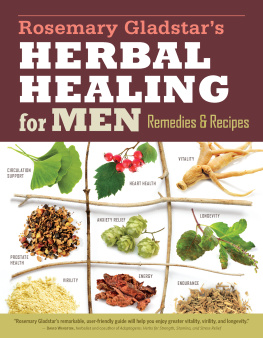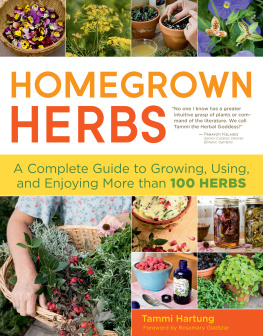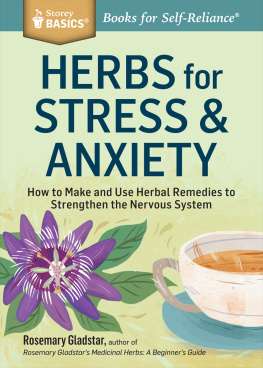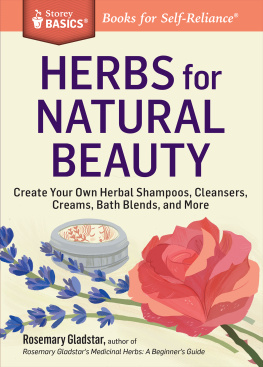Rosemary Gladstars
MEDICINAL HERBS
A Beginners Guide

The mission of Storey Publishing is to serve our customers by publishing practical information that encourages personal independence in harmony with the environment.
Edited by Deborah Balmuth and Nancy Ringer
Art direction and book design by Jessica Armstrong
Cover photography Jason Houston: front (top left & right, bottom left), back
(all); koi88/Dreamstime.com: front (bottom center); Saxon Holt: front
(top center, bottom right)
Interior photography by Jason Houston, except as noted on
Indexed by Nancy D. Wood
2012 by Rosemary Gladstar
All rights reserved. No part of this book may be reproduced without written permission from the publisher, except by a reviewer who may quote brief passages or reproduce illustrations in a review with appropriate credits; nor may any part of this book be reproduced, stored in a retrieval system, or transmitted in any form or by any means electronic, mechanical, photocopying, recording, or other without written permission from the publisher.
The information in this book is true and complete to the best of our knowledge. All recommendations are made without guarantee on the part of the author or Storey Publishing. The author and publisher disclaim any liability in connection with the use of this information.
Storey books are available for special premium and promotional uses and for customized editions. For further information, please call 1-800-793-9396.
Storey Publishing
210 MASS MoCA Way
North Adams, MA 01247
www.storey.com
Printed in the United States by Versa Press
10 9 8 7 6 5 4 3 2 1
LIBRARY OF CONGRESS CATALOGING-IN-PUBLICATION DATA
Gladstar, Rosemary.
Rosemary Gladstars medicinal herbs : a beginners guide / by Rosemary Gladstar.
p. cm.
Includes index.
ISBN 978-1-61212-005-8 (pbk. : alk. paper)
1. HerbsTherapeutic use. 2. Materia medica, Vegetable.
I. Title. II. Title: Medicinal herbs.
RM666.H33G538 2012
615.321dc23 2011053101
To my lovely grandchildren,
Andrew Ethan Colvard and Lily
Marie Carpenter, the herbalists
of tomorrow

CONTENTS
CHAPTER 1
Welcome to the Wonderful World of Medicinal Herbs
CHAPTER 2
How to Make Your Own Herbal Remedies



CHAPTER 3
9 Familiar Herbs & Spices to Grow and Use
CHAPTER 4
24 Safe & Effective Herbs to Know, Grow, and Use
CHAPTER 1
Welcome to the Wonderful World of Medicinal Herbs
RECOGNIZED AS THE OLDEST SYSTEM OF HEALING on the planet, herbal medicine traces its roots back to the earliest civilizations. Today, herbalism continues to flourish as a peoples healing art. Even with the amazing technological advances of conventional (allopathic) medicine, herbalism the art and science of healing with plants is still widely popular. And its popularity is gaining, not waning. According to the World Health Organization, 80 percent of the worlds population used some form of traditional medicine in 2008, and its rate of affordability, availability, and accessibility is surging.
So its no wonder youre drawn to these healing plants and curious to learn more about them. But perhaps youre nervous about trying herbal home remedies: What are these herbs? Are they safe? Do they work? Can you grow them at home? Can you make your own remedies? When and how do you use them? How easy is it to get started? These are some of questions well address in this book.


My Story
I was one of the lucky ones. When I was a child, my grandmother took me into the fields and showed me the wild plants she knew. Quietly, with a gentle but stern voice, she taught me their healing powers. When she weeded her garden, I was often kneeling beside her, watching her carefully sort the plants she pulled. I learned early which herbs went into the edibles basket and which went into the compost, and, as importantly, I learned why.
We were a farm family growing up in the wake of World War II. Resilient, hardy, and handy, we were taught to use what was available, useful, and inexpensive. Herbal remedies were one of those things. My grandmother had up her sleeve an armory of useful herbal remedies that she had learned over a long and difficult lifetime. She was a survivor of the Armenian genocide of World War I, and she told us grandkids that it had been her knowledge of plants and her faith in God that saved her life.
As kids, we suffered few illnesses or accidents that our grandmother and parents werent able to treat effectively at home with herbal remedies. In fact, I recall only two incidents that required a doctors care: when my younger sister swallowed rat poison (she survived, by the way) and when my older sister fell off the family horse and broke her hip. Not a bad record for a family with five active farm children... and good testament to the effectiveness of herbal home remedies.

Here I am with my younger sister and one of the calves on our family farm.
BOTANICAL BOOM
According to The Natural Pharmacy, by Schuyler Lininger et al., one out of every three adult Americans uses complementary/alternative medical care. Sales of botanicals have increased more than 300 percent since the 1990s and currently are an $8 billion industry.
What Is a Medicinal Herb?
If you use herbs in cooking, then youve already taken the first step in using herbal medicine. All of our common culinary herbs and spices are among our most important and esteemed herbal medicines. And if you garden, tucking herbs here and there in your vegetable and flower beds for their added scent and beauty, then you also have been practicing herbal medicine.
Garden herbs such as lavender, thyme, sage, basil, rosemary, mint, yarrow, and peppermint are some of our most trusted herbal medicines and have long histories of use as teas, salves, poultices, and tinctures for healing purposes. Open your refrigerator and you may find more common herbal remedies, including horseradish (one of the best remedies for sinus infections) and cabbage (a singularly effective poultice for shingles and hives).
But wait, you might say, arent some of these plants vegetables and not herbs? Botanically speaking, an herb is an herbaceous plant with a nonwoody stem. However, when herbalists speak of medicinal herbs, they are basically including any plant that can be used in healing. Remember, herbalism is an art that evolved over centuries around people and peoples needs. It only makes sense that people would use what they had available, in the kitchen or in the backyard. Many of the most common plants are still our best and most popular remedies for common ailments.













